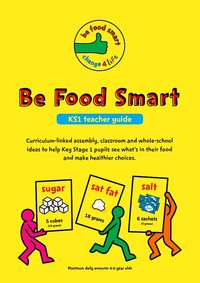Be Food Smart: KS1 toolkit
Use this guide to help teach your class what's in our food and how to make healthier swaps to eat less sugar, saturated fat and salt.
"The lesson plans are an excellent introduction to help unearth children's misconceptions about sugar."
Luke Thomas, KS1/2 teacher
Curriculum
Supports the english, mathematics and PSHE curricula
English – spoken
- Articulate and justify answers, arguments and opinions
- Give well-structured descriptions, explanations and narratives for different purposes
- Maintain attention and participate actively in collaborative conversations, staying on topic and initiating and responding to comments
- Consider and evaluate different viewpoints
English – reading comprehension
- Make inferences on the basis of what is being said and done
- Answer and ask questions
- Predict what might happen on the basis of what has been read so far
Mathematics
- Count, read and write numbers
- Identify and represent numbers using objects and pictorial representations
- Compare, describe and solve problems
- Mental fluency with whole numbers, counting and place value
- Solve problems with addition and subtraction mentally, and using concrete objects and pictorial representations
Science
- Identify and classify
- Use data to help answer questions
- Animals, including humans: describe the importance for humans of eating the right amounts of different types of food
PSHE
- Core Theme 1 Health and Wellbeing – healthy eating
In the classroom
Developed by educational experts, the Be Food Smart KS1 pack includes:
- Teacher guide – including a flexible, curriculum-linked lesson plan
- Lesson PowerPoint presentation – to use as a starter if pupils have not participated in the introductory Be Food Smart assembly
- Quiz sheet – test pupils' knowledge of sugar in their food and drink
- Sienna's story – to read out to your class
- Activity sheets – for Years 1 and 2
- Extension ideas – additional ideas for healthy eating activities
- Nutrition information sheet for teachers – explaining food label information
The lesson plan refers to three Be Food Smart films, featuring two children acting as investigative reporters to find out how they can eat a healthier breakfast.
Follow up the lesson by using the Be Food Smart: pupil campaign pack to develop your own pupil-led campaign, and help pupils find out what's in their food, compare products and make healthier choices.
Learning objectives
After the lesson, pupils will be able to:
- know that different food and drink contains varying amounts of sugar, saturated fat and salt
- use numerical data to work out the healthiest food and drink choices
- explain why it's important to make healthier choices
Resource details
- Topics: Schools
- Target audience: Students and teachers
- Published: 22 August 2024
- Last updated: 13 August 2024
